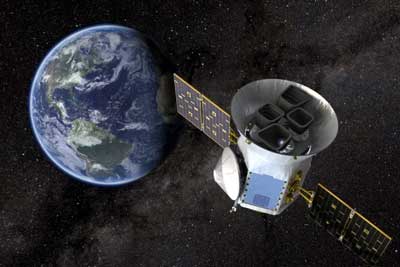| Apr 16, 2019 |
TESS discovers its first Earth-sized planet
|
|
(Nanowerk News) NASA’s Transiting Exoplanet Survey Satellite, TESS, has discovered its first Earth-sized exoplanet. The planet, named HD 21749c, is the smallest world outside our solar system that TESS has identified yet.
|
|
In a paper published today in the journal Astrophysical Journal Letters, an MIT-led team of astronomers reports that the new planet orbits the star HD 21749 — a very nearby star, just 52 light years from Earth. The star also hosts a second planet — HD 21749b — a warm “sub-Neptune” with a longer, 36-day orbit, which the team reported previously and now details further in the current paper.
|
|
The new Earth-sized planet is likely a rocky though uninhabitable world, as it circles its star in just 7.8 days — a relatively tight orbit that would generate surface temperatures on the planet of up to 800 degrees Fahrenheit.
|
 |
| NASA's Transiting Exoplanet Survey Satellite (TESS), shown here in a conceptual illustration, will identify exoplanets orbiting the brightest stars just outside our solar system. (Image: NASA's Goddard Space Flight Center)
|
|
The discovery of this Earth-sized world is nevertheless exciting, as it demonstrates TESS’ ability to pick out small planets around nearby stars. In the near future, the TESS team expects the probe should reveal even colder planets, with conditions more suitable for hosting life.
|
|
“For stars that are very close by and very bright, we expected to find up to a couple dozen Earth-sized planets,” says lead author and TESS member Diana Dragomir, a postdoc in MIT’s Kavli Institute for Astrophysics and Space Research. “And here we are — this would be our first one, and it’s a milestone for TESS. It sets the path for finding smaller planets around even smaller stars, and those planets may potentially be habitable.”
|
|
TESS has been hunting for planets beyond our solar system since it launched on April 18, 2018. The satellite is a NASA Astrophysics Explorer mission that is led and operated by MIT, and is designed to observe nearly the entire sky, in overlapping, month-long patches, or “sectors,” as it orbits the Earth. As it circles our own planet, TESS focuses its four cameras outward to monitor the nearest, brightest stars in the sky, looking for any periodic dips in starlight that could indicate the presence of an exoplanet as it passes in front of its host star.
|
|
Over its two-year mission, TESS aims to identify for the astronomy community at least 50 small, rocky planets, along with estimates of their masses. To date, the mission has discovered 10 planets smaller than Neptune, four of their masses which have been estimated, including Men b, a planet twice the size of Earth, with a six-day orbit around its star; LHS 3844b, a hot, rocky world that’s slightly bigger than Earth and circles its star in a blistering 11 hours; and TOI 125b and c — two “sub-Neptunes” that orbit the same star, both within about a week. All four of these planets were identified from data obtained during TESS’ first two observing sectors — a good indication, the team writes in its paper, that “many more are to be found.”
|
|
Dragomir picked out this newest, Earth-sized planet from the first four sectors of TESS observations. When these data became available, in the form of light curves, or intensities of starlight, she fed them into a software code to look for interesting, periodic signals. The code first identified a possible transit that the team later confirmed as the warm sub-Neptune they announced earlier this year.
|
|
As is usually the case with small planets, where there’s one, there are likely to be more, and Dragomir and her colleagues decided to comb through the same observations again to see if they could spot any other small worlds hiding in the data.
|
|
“We know these planets often come in families,” Dragomir says. “So we searched all the data again, and this small signal came up.”
|
|
The team identified a small dip in the light from HD 21749, that occurred every 7.8 days. Ultimately, the researchers identified 11 such periodic dips, or transits, and determined that the star’s light was being momentarily blocked by a planet about the size of the Earth.
|
|
While this is the first Earth-sized planet discovered by TESS, other Earth-sized exoplanets have been discovered in the past, mainly by NASA’s Kepler Space Telescope, a since-retired telescope that monitored more than 530,000 stars. In the end, the Kepler mission detected 2,662 planets, many of which were Earth-sized, and a handful of those were deemed to be within their star’s habitable zone — where a balance of conditions could be suitable for hosting life.
|
|
However, Kepler observed stars that are many leagues further away than those that are monitored by TESS. Therefore, Dragomir says that following up on any of Kepler’s far-flung, Earth-sized planets would be much harder than studying planets orbiting TESS’ much closer, brighter stars.
|
|
“Because TESS monitors stars that are much closer and brighter, we can measure the mass of this planet in the very near future, whereas for Kepler’s Earth-sized planets, that was out of the question,” Dragomir says. “So this new TESS discovery could lead to the first mass measurement of an Earth-sized planet. And we’re excited about what that mass could be. Will it be Earth’s mass? Or heavier? We don’t really know.”
|

